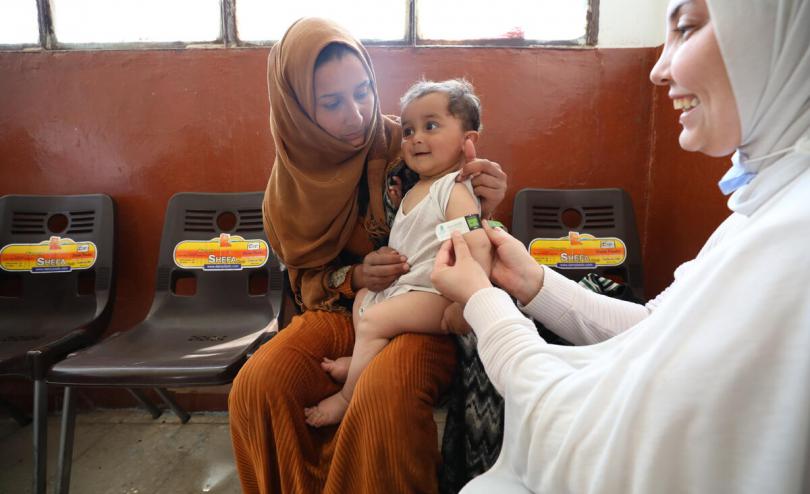GLOBAL GOALS: Nearly one child born every second faces risk of stunted growth by 2030 without action

- Leaders to meet 18-19 Sept for the 2023 Sustainable Development Goals (SDG) Summit in New York
- The summit marks the mid-way point towards the 2030 deadline for achieving the globlal goals and aims to prompt a new wave of high-level political commitment on actions.
UNITED NATIONS, 14 Sept 2023 – An estimated 194 million children born between now and 2030 will have stunted growth unless world leaders gathering next week at the Sustainable Development Goals (SDG) Summit urgently accelerate progress towards meeting the goals, said Save the Children.
The latest findings from Save the Children’s new data visualization tool, the Child Atlas [childatlas.org] , expose the grim consequences of global inaction in addressing rising levels of malnutrition, which countries committed to end in SDG2 on zero hunger.
If current stunting trends persist, nearly one newborn on average will be stunted every second over the next seven years.
Stunting damages growth and development in children who are under nourished or have poor nutrition and can have devastating lifelong effects—making them more susceptible to disease and infection and damaging their physical and cognitive development.
Countries in Sub-Saharan Africa are expected to bear the heaviest burden, estimated to account for 86 million cases of stunting for children born between 2023 and 2030, followed closely by South Asia with 67 million cases. The Eastern Asia and Pacific region is set to witness nearly 22 million stunted children, while the Middle East and North Africa brace for 9.6 million cases, and Latin and Central America anticipate 6.7 million children facing stunted growth.
Pakistan and the Democratic Republic of Congo (DRC) stand among the top four countries expected to face the highest levels of stunting in the next seven years with over 25% of their populations currently experiencing crisis levels of hunger.
The Child Atlas also found that more than half of projected stunting cases to children born in the next seven years will happen to children living in the poorest 40% of households, underscoring the impact of extreme poverty on children’s development.
While stunting has steadily decreased since 2000, progress has fallen short of the internationally agreed targets of 100 million cases by 2025 or to eradicate all forms of malnutrition by 2030.
Nana Ndeda, Head of Advocacy and Policy for Hunger at Save the Children, said:
“About 194 million children born between now and 2030 will suffer from stunted growth–nearly one child every second for the next seven years. That’s more than all the children under 18 currently living in the G7 countries combined.
“The silent crisis of stunting speaks volumes about how much work is still needed to address the global hunger crisis to reach the SDGs by 2030. If we do not eradicate all forms of malnutrition in the next seven years, an entire generation of children will suffer the ripple effects of hunger. Children must be at the forefront of all decisions at next week’s UNGA; their futures depend on it.
“Although immediate funding is critical to saving lives now, we need longer-term solutions and changes to systems that will stop this crisis from recurring. Reactive humanitarian funding is too slow, unreliable, costly and ultimately ineffective to tackle the complex crises of today. World leaders must invest in early warning systems and disaster preparedness to better prepare for future shocks and mitigate the impacts before it is too late. We also need world leaders to commit to an overhaul of the global financial systems to unlock the finance needed at scale to deliver the SDGs for all people everywhere, in line with the pledge to Leave No One Behind.”
Save the Children is calling on world leaders at the UNGA to address the root causes of acute food and nutrition insecurity. Only by putting an end to global conflict, by tackling the climate crisis and global inequality, and by building more resilient health, nutrition and social protection systems that are less vulnerable to shocks like COVID-19, will we be able to ensure the same warnings are not ringing out again in the coming years.
The child right’s organisation is also calling for greater collaboration, dialogue and investment across sectors with, and leadership by, local communities, to bolster response planning and implementation, as well as our abilities to act early and prevent predictable shocks from turning into crises. Save the Children is also calling on world leaders to scale up low-cost interventions to prevent and treat malnutrition: community-based treatment for acute malnutrition, supporting and protecting breastfeeding, and investing in community and primary-level healthcare.
ENDS
Notes to Editor:
- The Child Atlas integrates the most recent data from a range of publicly available data sources, including UNICEF, WHO, UNESCO, the World Bank, as well as data curated by civil society organisations and academia.
- If the current stunting rates continue, the Child Atlas estimates 194 million children born between Jan 2023 and December 2029 are expected to experience stunted growth.
- Between 1 January 2023 and 31 December 2029, there will be 220,924,800 seconds. 194,000,000 divided by 220,924,800 seconds = 0.87. On average, nearly one child born each second between now and 2030 is estimated to be stunted.
- 51% of all stunting cases happen to children living in the poorest 40% of households (this is based on 99 countries, representing 85% of all stunting cases).
- At a national level, Pakistan (14.2m) and DRC (11.6m) are among the top four countries expected to face high levels of stunting in the next seven years. Both nations are currently suffering with crisis levels of hunger or worse, with Pakistan grappling with 29% of its population in IPC 3+ and DRC with 25% of its population in IPC3+, as of August 31, 2023
- According to child population data from UNICEF, there are currently more than 148 million children under the age of 18 living in G7 countries (the US, France, Germany, Japan, the UK, Italy, and Canada), about 45 million less than the number of children projected to be born between now and 2030 who will suffer from stunted growth.
For media enquiries:
- Daphnee Cook Daphnee.cook@savethechildren.org / +254 717 524 904
- Samantha Halyk samantha.halyk@savethechildren.org
- Our media out of hours (BST) contact is media@savethechildren.org.uk / +44(0)7831 650409
Please also check our Twitter account @Save_GlobalNews for news alerts, quotes, statements and location Vlogs.




